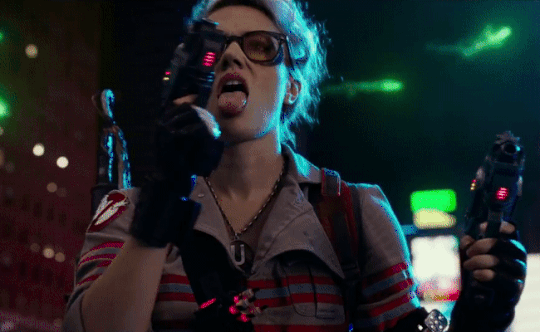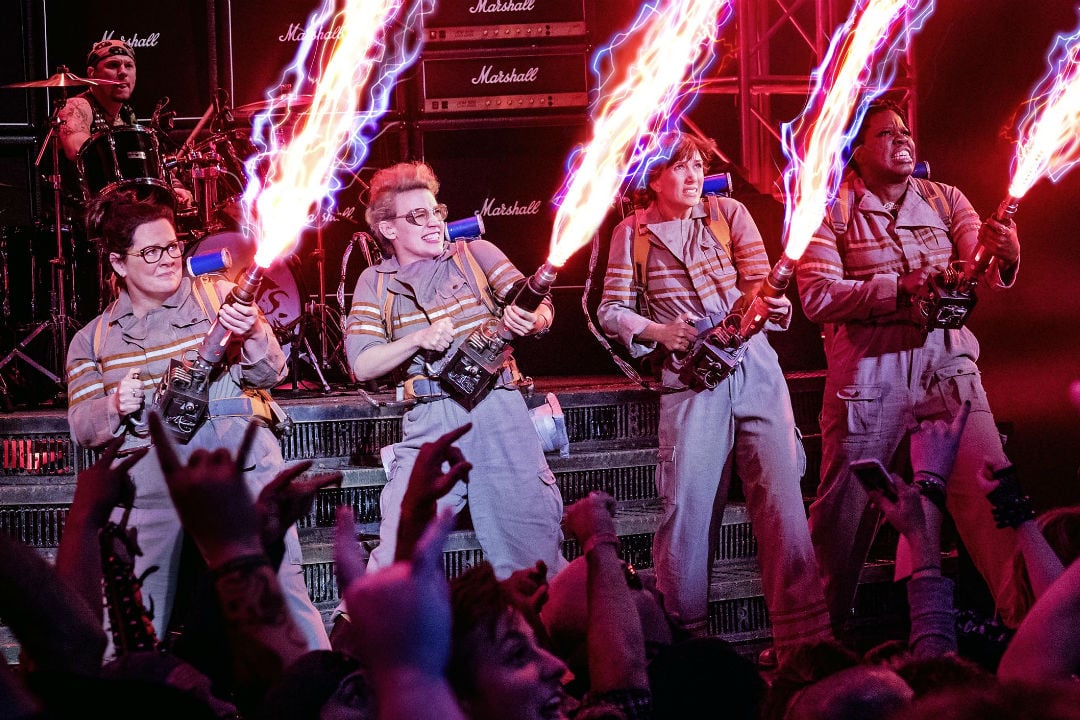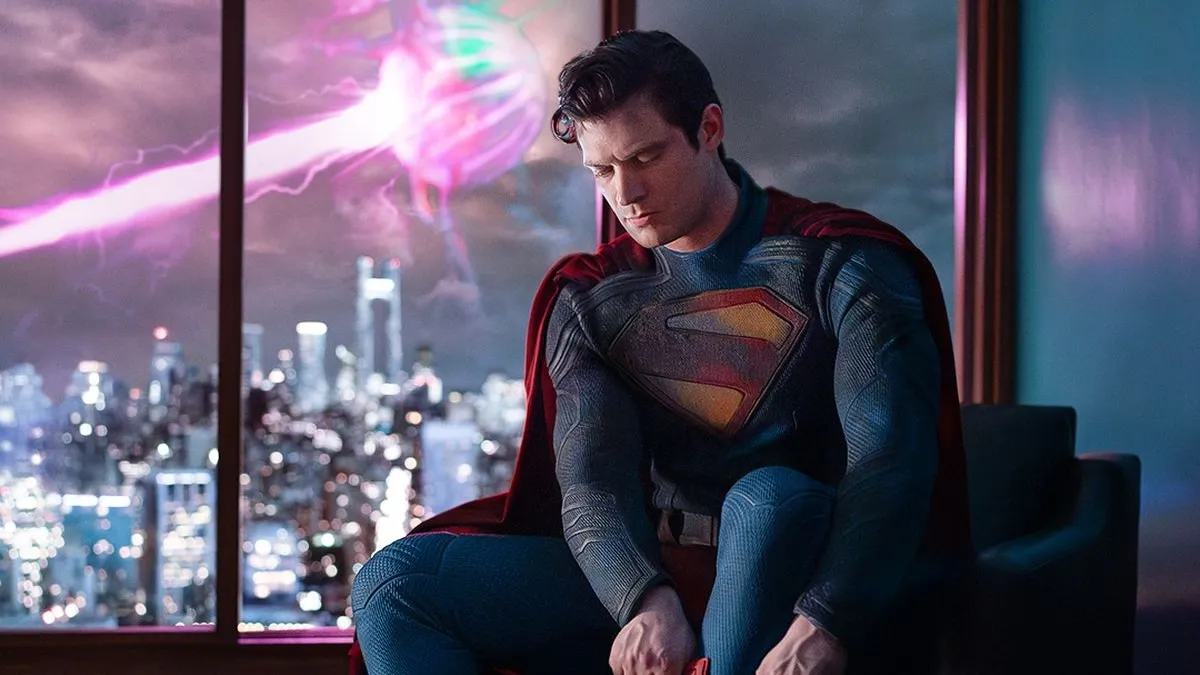Get ready to feel the sting of existential dread, because it’s time to talk about the political implications of Ghostbusters. This movie has been so heavily scrutinized ahead of its release that it’s almost impossible to evaluate in a vacuum, and the movie itself seems grimly aware of that. Predictably, a lot of the early criticism of the movie has revolved around whether or not it’s funny and whether it’s not it’s feminist and whether or not one of those things is somehow related to the other. I don’t know about all of you, but I’m exhausted.
Truth be told, I just don’t think it’s ever going to be valuable to ask “Is [piece of media] feminist?” I don’t think a piece of media can “be feminist,” since feminism is something you do, not a state of being or an on/off switch. But I still think it’s valuable to evaluate the political themes of this movie. Because, yes, Ghostbusters is a political movie, while also being a very silly movie about Kate McKinnon accidentally lighting objects on fire while dancing around a laboratory.
The original Ghostbusters was a political movie, too. As Peter Suderman explains at length in a piece about the 1984 Ghostbusters, the original had plenty to say about academia and bureaucracy as seen through the lens of small business owners. However, I disagree with Suderman’s evaluation of the 2016 film, which he seems to think has next to no political commentary.
I keep having the “did we see the same movie?” moment when it comes to the new Ghostbusters, and this is no exception. Personally, I felt like the political commentary in the new Ghostbusters movie had all the subtlety of an anvil, but given how few people I’ve seen talking about that aspect, I guess I must be imagining things … which means I’ve got something in common with the new Ghostbusters team, since the entire theme of their movie is that no one will believe them and no one will ever take them seriously.
I don’t think the new Ghostbusters is “feminist” or even “about feminism,” necessarily – but it is about gender, and it is about sexism, and it is also about race (albeit not nearly as much as it could stand to be).
The original Ghostbusters is also about gender, and about anxious masculinity, and about the inaccessible ice queen purity of Sigourney Weaver’s character – who, post-possession, transforms into a lusty seductress who can’t get enough of the guy she’s been politely rebuffing for the entire movie hence. This is a movie that throws Sigourney Weaver together with Rick Moranis, the Nice Guy Nerd she’s been avoiding, in a Doomsday scenario that will result in her getting rescued by the Jerk Guy she’s also been avoiding … but of course, we see all of this from the guys’ point of view. This is a movie about small business owners who learn about the existence of ghosts and find a way to turn it into a viable business model and pick up chicks in the process. This is a movie that features, famously, a scene in which Dan Aykroyd gets a blow job from a ghost … and, of course, the movie is careful to render this ghost as explicitly feminine. This is a movie that opens with a female librarian seeing a ghost and then getting disbelieved; Bill Murray’s character asks her if she’s “menstruating” (when asked by a bystander why that question is relevant, he smirks, “I’m a scientist”). Oh, and the fact that Ernie Hudson’s characterization got screwed over by Bill Murray’s unexpected addition to the cast should tell you a lot about the original Ghostbusters‘ take on racial politics, both in front of the camera and behind it.
The new Ghostbusters serves both as a standalone movie about four women who just so happen to prove that ghosts are real – as well as a movie that is also an implicit commentary about its own historical implications. After all, a movie about ghosts should also be a movie about history, right? And in the new Ghostbusters‘ case, that history is ugly – it’s attacking the present day, and trying to keep us all stuck in the past.
Ghostbusters 2016 opens with a historical tour through a mansion haunted by a lady-ghost, but she’s a far cry from the ghostly gal who hooks up with Dan Aykroyd in the first movie. This new ghost is a mega-rich murderess who killed a ton of her own servants, and her parents were so concerned about potential scandal that instead of handing their daughter over to the authorities, they locked her up in their own basement. (That concern about scandal will come up again later in this movie, by the way, once the Ghostbusters start making waves.)
Statistically, women are almost never mass-murderers. In fact, homocidal women are so rare that scientists don’t have enough cases to effectively evaluate them. Anyway, this movie is predicated upon the idea that only “bad” ghosts are being brought back from the dead, because the villain orchestrating all of these hauntings has set it up that way. Still, I don’t think it’s any accident that the movie intentionally positions this woman first in the lineup; she’s an example of Victorian patriarchal oppression gone horribly wrong – a total what-not-to-do scenario.
Anyway, in this version of Ghostbusters, no one believes that ghosts are real, and no one believes that bustin’ ghosts is a viable business strategy. In the original movie, Bill Murray doesn’t believe in the paranormal, but he doesn’t think that it really matters either way; he can still pick up women and make money off of it, whether it’s fake or real. In his case, ghosts do turn out to be real, but that isn’t the sticking point around which the movie revolves. In the new Ghostbusters, the collective disbelief in ghosts is the entire crux of the story. It turns out that when two women write a book together about ghosts, it gets seen as touchy-feely quackery.
I explained this a bit in my discussion of the use of magic vs. sci-fi in my evaluation of the Marvel movie universe, but it’s worth reiterating the point again here. The use of magic as a narrative device has classically been associated with femininity – whether it’s witchcraft or Tarot cards or astrology or psychics or mediums. From my own anecdotal experience, every all-girl slumber party that I attended in my youth included a lot of ghost-summoning attempts, and Bloody Mary stood us up several times over. Ghost stories aren’t exclusively a “lady thing,” but science is definitely still seen as a “guy thing” (sigh), and sci-fi doesn’t typically include ghosts, so there you have it.
Ghostbusters is the big exception, really. That’s part of why the original Ghostbusters was so hilarious and unexpected. You take a ghost story, something that has no scientific or logical basis, then slather it up with a bunch of scientific jargon and sci-fi weaponry and whatnot. Add in a bunch of super-macho scientists and dress ’em up in scrubs and give ’em cool weapons. If ghosts were real? Well, scientists would study them, that’s for sure.
All of this subtext gets put front-of-mind in the new version of Ghostbusters, where Kristen Wiig’s character, Erin Gilbert, is also working at Columbia University – just like the three scientists do in the first Ghostbusters – before she, like them, loses her job. But in her case, the circumstances of the firing are quite different. She’s trying to secure tenure, and the scene with her boss (played by Charles Dance of Game of Thrones fame) revolve around the double standards she’s up against at work. Even though she has a recommendation from Princeton, Dance’s character says that she needs to get one from a more prestigious university. (“More prestigious than Princeton,” she boggles.) As he walks out the door, he makes a snide comment about her outfit choices at work. She gestures to her skirt suit and earnestly asks: “Too sexy?”
The joke here, of course, is that Erin’s outfit is hilariously conservative. But Charles Dance’s character doesn’t even respond to her; he mutters, “Never mind,” and keeps walking. She never does find out what’s wrong with her outfits, and it’s implied that nothing would actually be good enough anyway.
The real source of her anxiety, though, is that she used to believe in ghosts and she published a book arguing to that effect. Why does she believe in ghosts? Because, as we learn later in the movie, as a child she saw the ghost of her next-door neighbor appear by her bedside every single night for a year. No one believed her – except for Melissa McCarthy’s character, Abby, which is how the two became friends and soon became determined to prove, via science, that ghosts exist. When Patty (Leslie Jones) and Holtzmann (Kate McKinnon) hear this story for the first time, they echo the sentiment. They, too, would have believed Erin.
This scene might seem out-of-place and strange, I suppose, if you can’t figure out the larger implications within the context of the movie’s themes. For me, the parallels seemed obvious. Women, especially young girls, are not believed when it comes to their own experiences. It doesn’t matter how long the experience goes on or how bad it is or how much evidence there might be. The whole “lying for attention” myth, even though that type of lie could cost a woman her career (and does, in Erin’s case), keeps haunting these women.
Even after the team of Ghostbusters proves, over and over, in front of huge crowds of people, that ghosts are definitely real – the authorities still paint them as liars who just want to get media attention. Even though the government secretly supports the Ghostbusters and desperately need their help, they refuse to endorse these women in public.
Bill Murray’s cameo involves him literally wearing a fedora and playing the role of a skeptic who doesn’t believe in ghosts. He bullies Erin into releasing a ghost, in spite of Abby’s protestations that his opinion doesn’t matter, and the ghost then attacks him and throws his character out the window, after which point he’s never seen again. I’ve seen complaints from people saying that this cameo isn’t very funny. They are right. This scene is not very funny. But I don’t think that was the point of that particular moment. By throwing Murray and his fedora out the window, the new Ghostbusters has also dispensed of the person he represents – the disbelieving “well, prove it” guy who can’t be swayed by evidence. Add in the additional implication of the character type that Bill Murray played in the first Ghostbusters, and the scene makes even more sense.
Meanwhile, there’s also the villain of the entire movie – Rowan, about whom we’ve already written. In the first standoff between Rowan and the Ghostbusters, he explains that he’s been reviving ghosts and taking over the city because he was bullied and he wants to rule over the world. One of his lines is, “I see things that no one else does, and for it, I am rewarded with nothing but scorn and mockery.”
In response, Abby points out that his experience precisely matches up with the experiences of herself and her fellow bustin’ peers. They were all ridiculed, disbelieved, and not taken seriously–they’re still not taken seriously. But instead of wanting to rule the world, they still want to save it. This results in a joke wherein the Ghostbusters try to think of good things about the world that make it worth saving, and all they can think of is soup and salad. Soup is pretty good! But, really, the Ghostbusters have been totally shit upon. Why do they want to save the world? Especially a world that has undermined them, over and over again, no matter what they do!?
The culmination of our heroines’ battle with Rowan in Ghostbusters involves him gleefully announcing that he’s taking the streets of New York City back to the past. The women fight back against ghosts who look like various historical leaders and soldiers. There’s a ghost inhabiting a balloon that looks like President Lincoln. There’s some Pilgrims, plus the Victorian lady ghost makes her return, plus I’m pretty sure I saw a couple of Revolutionary War soldiers. Oh, and then there’s a huge stilt-walker ghost dressed as Uncle Sam. The climax of this battle starts with Holtzmann licking one of her two pistols before thrashing all of these ghosts into submission, finishing off with wrapping her proton lasso around Uncle Sam. Considering what Uncle Sam represents, there’s no way not to interpret this battle as political.
 (image via Giphy)
(image via Giphy)
Patty is the Ghostbuster who is the history buff, and she’s the one who’s quick to point out the historical implications of each of their encounters and the reasons why each ghost might have a bone to pick with humanity. From a larger metaphorical standpoint, the idea of past historical disputes resting deep below the streets of New York City, then rising up to rear their ugly heads once more on an unsuspecting populace … well, it’s both timely and timeless. I would have loved to see Ghostbusters lean more into this theme with Patty’s character, allowing her to prove to the trio of scientists that the ivory tower isn’t always in touch with what’s happening on the ground (or underground, in the case of Patty’s MTA job). The idea that there’s an undercurrent of sexist and racist resentments, upon which our country was founded, would make for a haunting overall theme, if only it had gotten spelled out a bit more. Especially the part where no one will believe you about any of these problems, even if they’re staring you right in the face and spitting ectoplasm all over you.
The ghosts of the past don’t really “die” in this movie; instead, they get sucked back underground, where they’ll presumably stay, unless someone tries to wrestle them all back to the surface again. The apocalypse gets orchestrated by a human villain who wanted power and invoked the most disgusting denizens of American history in order to seize it. Even the ghosts themselves are pawns in the larger scheme, which is a human one.
The original Ghostbusters, which celebrated the private sector, was apparently beloved by Reagan voters and had an unquestionable conservative and libertarian ethos. The new one? Well … given its themes, is it really any surprise that “original” Ghostbusters fans feel like this one is an abandonment of everything the original movie stood for? The new movie ends with the government deciding to completely support the Ghostbusters and provide them with the funding they need in order to keep their business running. This movie isn’t an argument in favor of privatization and limiting governmental influence. Instead, it’s a movie about marginalized people finally getting the resources that they deserve, but only after decades of getting ignored and mocked.
Does Ghostbusters manage to juggle all of these narrative threads effectively? Perhaps not, since there’s plenty of time for slapstick and jokes about the Jaws mayor. But if we’re going to overthink the original Ghostbusters, then I think we may as well give the new one the same treatment, because I think there’s actually a lot more to chew here beyond the cursory question of whether or not it’s “funny.”
Oh, and by the way, I did think it was funny. But perhaps that argument will have to wait for another day.
—The Mary Sue has a strict comment policy that forbids, but is not limited to, personal insults toward anyone, hate speech, and trolling.—
Follow The Mary Sue on Twitter, Facebook, Tumblr, Pinterest, & Google+.








Published: Jul 25, 2016 12:50 pm